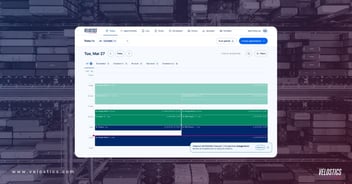Logistics Survey Results: Industry Trends & Best Practices
As the procurement and logistics landscape evolves, manufacturers face a myriad of supply chain challenges that necessitate innovative solutions. Material planners and buyers find themselves increasingly entangled in the logistics web, spending a significant portion of their time on manual tasks that, while crucial, distract from core objectives and pose operational risks. In this post, we dive into the findings of our industry survey, exploring trends, best practices, and opportunities for improvement.
The Industry Survey: A Glimpse into Reality
Our survey, "Solving Receiving Logistics Challenges and Setting Up Procurement for Success," delves into the experiences of professionals grappling with the dynamic landscape of procurement and logistics.
The key highlights include:
- Task Separation and Collaboration for Inbound Loads: In today's fast-paced manufacturing environment, the efficient management of inbound loads is crucial. To tackle this challenge, manufacturers are adopting task separation and collaboration strategies. By dividing the tasks involved in receiving and processing inbound loads among different team members, manufacturers can streamline their operations and improve overall efficiency. This approach ensures that each task is assigned to the most qualified individual, reducing errors and delays. Additionally, collaboration among team members allows for effective communication and coordination, enabling a smooth flow of materials throughout the supply chain.
- Automation and Tools Making Real Quantifiable Impact: With the advent of advanced technologies, automation has become a game-changer in the procurement and logistics landscape. Manufacturers are increasingly leveraging automation and specialized tools to optimize their operations and achieve quantifiable results. From automated data entry and inventory management systems to predictive analytics and machine learning algorithms, these tools eliminate manual tasks and provide real-time insights. By implementing automation, material planners and buyers can save valuable time, allowing them to focus on more strategic and high-value activities. Furthermore, automation enhances accuracy, reduces errors, and improves overall decision-making, leading to increased operational efficiency and cost savings.
- Delivery Delays and Reducing Unknown POs: This can cause significant disruptions to production schedules and result in increased costs. To address this issue, manufacturers should implement strategies to enhance visibility into delivery schedules and reduce the occurrence of unknown POs. By leveraging advanced tracking technologies, such as GPS and RFID, manufacturers can closely monitor the movement of goods and proactively identify potential delays. Additionally, implementing robust communication channels with suppliers and using electronic data interchange (EDI) systems can help reduce the occurrence of unknown POs, ensuring smoother operations and improved customer satisfaction.
- Wait Times and Detention Control: Waiting times and detention control are critical aspects of effective supply chain management. Excessive wait times at docks can lead to bottlenecks, increased costs, and delays in production. To optimize wait times, manufacturers can leverage dock scheduling software. This technology allows for the efficient allocation of dock space and resources, ensuring that trucks are scheduled and processed in a timely manner. By reducing wait times, manufacturers can improve overall supply chain efficiency, minimize disruptions, and enhance customer satisfaction. Additionally, detention control measures, such as implementing penalties for excessive detention or incentivizing faster turnaround times, can encourage carriers to prioritize timely pick-ups and deliveries, further improving supply chain resilience.
Opportunities for Improvement
Our survey not only identifies industry trends but also provides a roadmap for improvement. Explore opportunities to:
- Streamline Inbound Load Processes: Leverage task separation and collaboration strategies to streamline inbound load processes, reducing manual efforts and enhancing overall efficiency.
- Embrace Automation: Learn how automation and specialized tools can bring tangible benefits, freeing up valuable time for material planners and buyers to focus on high-value tasks.
- Enhance Visibility: Implement strategies to enhance visibility into delivery schedules and reduce the occurrence of unknown POs, minimizing disruptions in manufacturing operations.
- Optimize Detention Control: Discover the role of dock scheduling software in optimizing detention control, reducing wait times, and enhancing overall supply chain resilience.
In an era of evolving supply chain dynamics, staying ahead requires a keen understanding of industry trends and proactive strategies.
Curious to delve deeper into the survey findings and explore real-world examples? Click here to access the recorded webinar, where industry experts discuss the challenges and share insights on how to navigate the evolving landscape of procurement and logistics.


